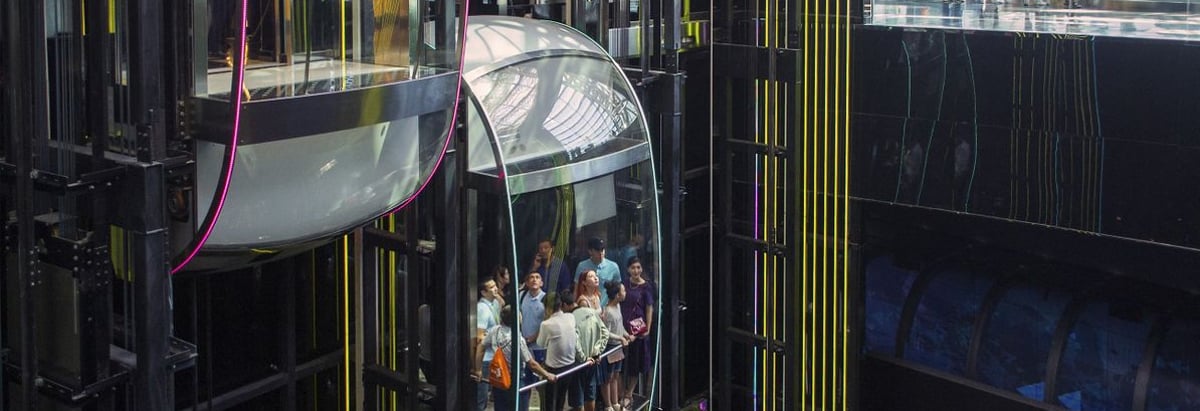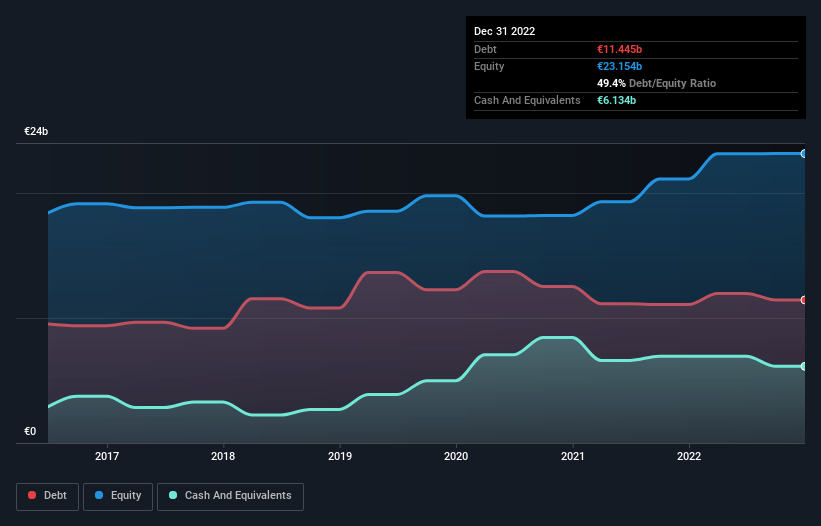Compagnie de Saint-Gobain (EPA:SGO) Has A Pretty Healthy Balance Sheet

Some say volatility, rather than debt, is the best way to think about risk as an investor, but Warren Buffett famously said that 'Volatility is far from synonymous with risk.' So it might be obvious that you need to consider debt, when you think about how risky any given stock is, because too much debt can sink a company. As with many other companies Compagnie de Saint-Gobain S.A. (EPA:SGO) makes use of debt. But the real question is whether this debt is making the company risky.
When Is Debt A Problem?
Debt assists a business until the business has trouble paying it off, either with new capital or with free cash flow. Ultimately, if the company can't fulfill its legal obligations to repay debt, shareholders could walk away with nothing. However, a more usual (but still expensive) situation is where a company must dilute shareholders at a cheap share price simply to get debt under control. Having said that, the most common situation is where a company manages its debt reasonably well - and to its own advantage. The first thing to do when considering how much debt a business uses is to look at its cash and debt together.
Check out our latest analysis for Compagnie de Saint-Gobain
What Is Compagnie de Saint-Gobain's Net Debt?
The chart below, which you can click on for greater detail, shows that Compagnie de Saint-Gobain had €11.4b in debt in December 2022; about the same as the year before. However, it does have €6.13b in cash offsetting this, leading to net debt of about €5.31b.

How Healthy Is Compagnie de Saint-Gobain's Balance Sheet?
Zooming in on the latest balance sheet data, we can see that Compagnie de Saint-Gobain had liabilities of €17.4b due within 12 months and liabilities of €14.9b due beyond that. On the other hand, it had cash of €6.13b and €6.70b worth of receivables due within a year. So it has liabilities totalling €19.4b more than its cash and near-term receivables, combined.
This deficit is considerable relative to its very significant market capitalization of €27.8b, so it does suggest shareholders should keep an eye on Compagnie de Saint-Gobain's use of debt. Should its lenders demand that it shore up the balance sheet, shareholders would likely face severe dilution.
We measure a company's debt load relative to its earnings power by looking at its net debt divided by its earnings before interest, tax, depreciation, and amortization (EBITDA) and by calculating how easily its earnings before interest and tax (EBIT) cover its interest expense (interest cover). The advantage of this approach is that we take into account both the absolute quantum of debt (with net debt to EBITDA) and the actual interest expenses associated with that debt (with its interest cover ratio).
Compagnie de Saint-Gobain has a low net debt to EBITDA ratio of only 0.82. And its EBIT easily covers its interest expense, being 19.3 times the size. So you could argue it is no more threatened by its debt than an elephant is by a mouse. And we also note warmly that Compagnie de Saint-Gobain grew its EBIT by 20% last year, making its debt load easier to handle. When analysing debt levels, the balance sheet is the obvious place to start. But it is future earnings, more than anything, that will determine Compagnie de Saint-Gobain's ability to maintain a healthy balance sheet going forward. So if you want to see what the professionals think, you might find this free report on analyst profit forecasts to be interesting.
Finally, while the tax-man may adore accounting profits, lenders only accept cold hard cash. So it's worth checking how much of that EBIT is backed by free cash flow. Over the last three years, Compagnie de Saint-Gobain recorded free cash flow worth a fulsome 86% of its EBIT, which is stronger than we'd usually expect. That positions it well to pay down debt if desirable to do so.
Our View
Happily, Compagnie de Saint-Gobain's impressive interest cover implies it has the upper hand on its debt. But truth be told we feel its level of total liabilities does undermine this impression a bit. Taking all this data into account, it seems to us that Compagnie de Saint-Gobain takes a pretty sensible approach to debt. While that brings some risk, it can also enhance returns for shareholders. The balance sheet is clearly the area to focus on when you are analysing debt. But ultimately, every company can contain risks that exist outside of the balance sheet. To that end, you should be aware of the 1 warning sign we've spotted with Compagnie de Saint-Gobain .
If, after all that, you're more interested in a fast growing company with a rock-solid balance sheet, then check out our list of net cash growth stocks without delay.
New: AI Stock Screener & Alerts
Our new AI Stock Screener scans the market every day to uncover opportunities.
• Dividend Powerhouses (3%+ Yield)
• Undervalued Small Caps with Insider Buying
• High growth Tech and AI Companies
Or build your own from over 50 metrics.
Have feedback on this article? Concerned about the content? Get in touch with us directly. Alternatively, email editorial-team (at) simplywallst.com.
This article by Simply Wall St is general in nature. We provide commentary based on historical data and analyst forecasts only using an unbiased methodology and our articles are not intended to be financial advice. It does not constitute a recommendation to buy or sell any stock, and does not take account of your objectives, or your financial situation. We aim to bring you long-term focused analysis driven by fundamental data. Note that our analysis may not factor in the latest price-sensitive company announcements or qualitative material. Simply Wall St has no position in any stocks mentioned.
About ENXTPA:SGO
Compagnie de Saint-Gobain
Designs, manufactures, and distributes materials and solutions for the construction and industrial markets worldwide.
Flawless balance sheet, good value and pays a dividend.
Similar Companies
Market Insights
Community Narratives



